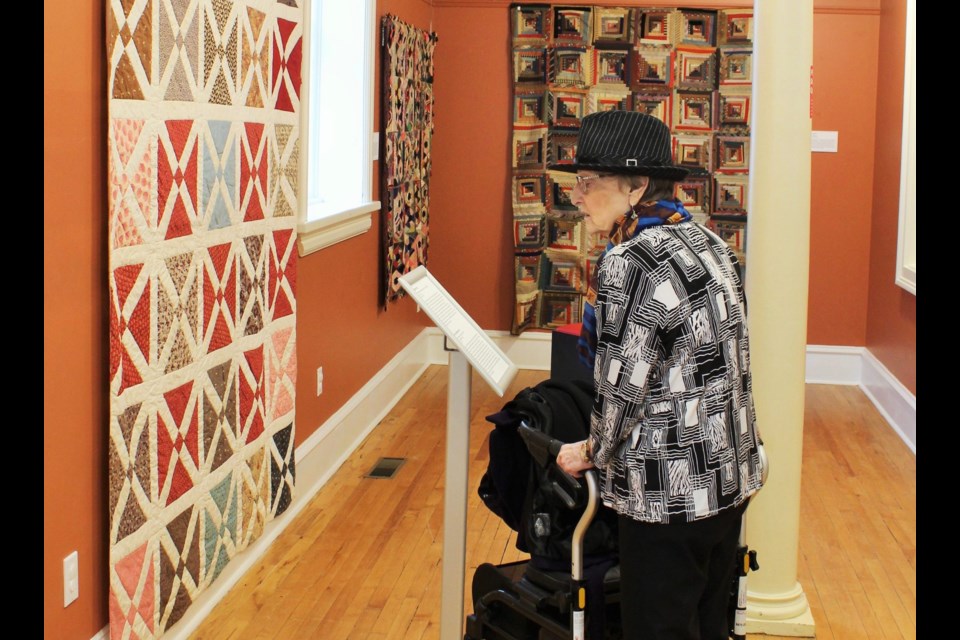Laura Secord may be a household name to the residents of Niagara-on-the-Lake, but women such as Susan Chubbuck, Ann Clement, Mary Miller Ball and Elizabeth Smith are less well-known although not forgotten, thanks to the current exhibit at the newly named Niagara-on-the-Lake Museum (formerly The Niagara Historical Society & Museum).
This exhibit, which runs until April 25, celebrates the lives of these women through their textiles. On display are samples of quilts, needlepoint, embroidery, woven textiles, coverlets, and pillows. The tools of their trade are also on display. There are looms, spinning wheels and a beautifully ornate ebony sewing box complete with bobbins embellished with mother-of-pearl and dainty silver scissors.
According to Shawna Butts, curator of the exhibit, this display gives us a “unique perspective” by focusing on women’s contribution to the history of the town. By working in textiles, whether they be weaving, needlepoint or quilting, women were able to express themselves through their craft. The textiles on display come from the museum’s own inventory, which they received as donations, and were made by or for women from NOTL in the 18th and 19th centuries.
“Written records of women’s voices are rare to come by during the 18th and 19th centuries, but you can find traces of women and their experiences if you know where to look,” says Butts. “While written records of women’s voices are historically rare to find, quilts, samplers and coverlets serve as a testament that women lived and created.”
One unique piece is that of a quilt made by Laura Secord’s granddaughter, Augusta Smith, named Crazy Quilt. Dated 1888, it was created by stitching together pieces of embroidery made by Laura Secord. Another beautiful specimen is the Cradle Quilt, made by Augusta McCormick (nee Jarvis) dated 1845. It follows a honeycomb pattern in muted colours with a soft fringe. Although there is not much information about McCormick directly, it is assumed she must have led “a life of wealth and leisure, based on her father and husband’s positions within the Niagara community.” Her father, William Jarvis, was a provincial secretary and registrar to the Executive Council of Upper Canada, and her husband was the manager of the Bank of Upper Canada.
In addition to the samplers and quilts, there are also coverlets on display, woven on looms and made mainly from wool and cotton. One such coverlet is believed to have been woven by Eliza Magdalene Kirby (nee Whitmore), dated 1837. It displays a repeated four roses pattern.
According to the information from the museum, this pattern is often used as a wedding design. Again, not much is known about Kirby except that she married William Kirby, a local author and historian.
The goal for this exhibit is “to illuminate the lives of some of Niagara-on-the-Lake’s women,” looking at the quilts not just as utilitarian pieces, but as a way to highlight the women’s history.
Butts explains the exhibit coincides with the release of a book that is an historical account of women of NOTL. The tentative title at this point is simply, Women of Niagara-on-the-Lake, and puts women’s history in the forefront. Since the history of NOTL has been as a military town, men’s history has been the main focus. This book seeks to highlight stories of women from Niagara who challenged the norm of their times. Records of some of these women were involved in the courts as prosecutors, by charging men with domestic violence, while some found themselves on the other side of the law as defendants facing charges of prostitution, assault or swearing. Others faced charges of acts against temperance and operating taverns without a licence. Butts says that in 1801, there was a woman hanged for murder in the Queen Street Court House, as it was the district capital for the courts.
The book will also feature short biographies on more famous characters, as Molly Brant, Chloe Cooley, Janet Carnochan, Margherita Howe and Laura Dodson.
Butts is working on another biography for the book but explained other community members have also contributed. She expects it to come out in June.
As for the current exhibit, one of the oldest pieces on display is a sampler made by Elizabeth Smith, in 1749. Smith was the aunt of D. W. Smith, who was one of Upper Canada’s early Surveyor Generals. This needlework picture is beautifully decorated and intricate. It depicts red flowers resembling poppies with intertwining green vines, stems and leaves bordering rows of patterns and a verse. Smith stitched under her signature block the words, “This work in hand my friends may have when I am dead and laid in grave.”
Thank you Elizabeth for a peak into your world, and the world of other women of your age through your handiwork by giving us, your friends, your “work in hand.”
For more information on the museum and its special events and exhibitions, please visit www.nhsm.ca or call 905-468-3912.
The Museum is located at 43 Castlereagh Street and is open daily 1 p.m. to 5 p.m. to April. The exhibit, A Piece of Her Mind: Quilts & Coverlets, is on until April 25. The museum is also honouring Black History Month with Lunchbox Cinema on Fridays at 11:30 a.m.
The movies will run about an hour and viewers are encouraged to either pack a lunch or purchase snacks and refreshments at the museum. Remember Africville and Black Mother, Black Daughter will be shown on Feb. 21. Speakers for the Dead will be featured Feb. 28.
On Monday, Feb. 24 at 2 p.m., Peter Kemball will speak about Harry Nyquist as part of the Famous & Infamous: People & Events series.



